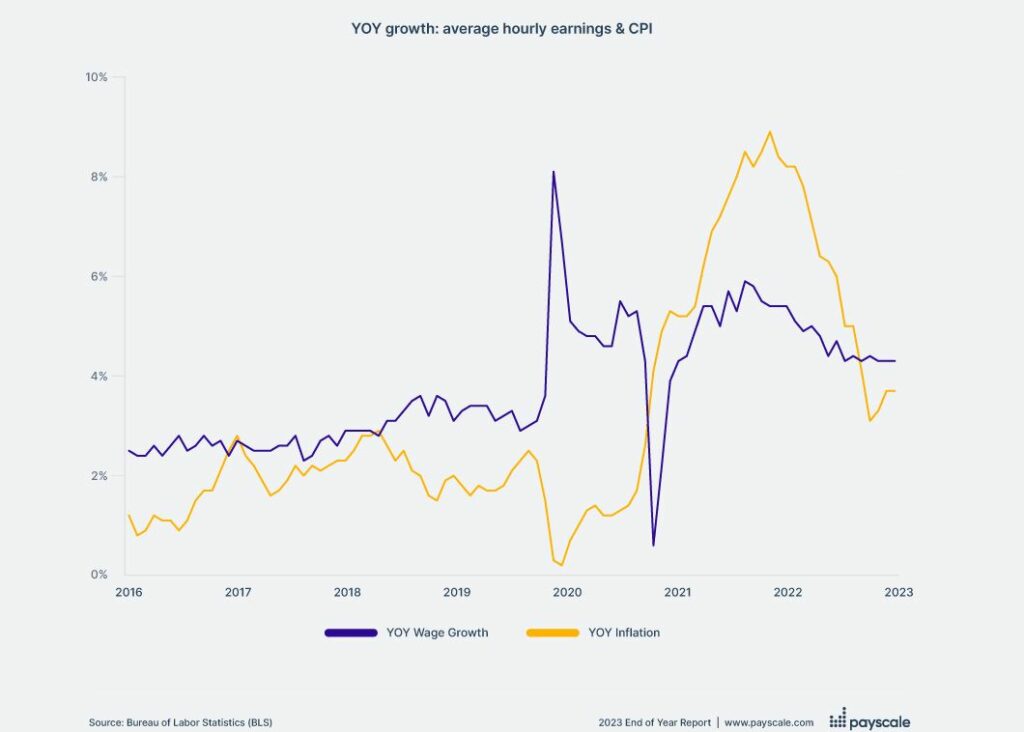
Pay increases expected to meet or exceed inflation in 2024, Payscale study says
By onAnnouncements | Business Practices | Collision Repair | Education | Market Trends
A report by Payscale predicts pay increases in the U.S. job market will meet or exceed inflation in 2024, and offers tips on how businesses can stay competitive when hiring for in-demand jobs, such as auto body repairer.
Auto body repairers were the fourth in-demand job in 2023, the report says. The medium pay was $52,100 in 2023, an increase of 21% from 2022. It followed assistant manager/customer service, hairdresser, and master plumber positions on the list.
“There is a shortage of automotive technicians due to an aging population, low pay, and a rising number of older cars,” the report said. “People are keeping their vehicles for longer, and older cars have become especially popular in the last year or two as rising interest rates have made new car purchases less affordable. In addition, interest in postsecondary programs in the automotive sector has dropped, likely due to less competitive salaries compared to other lines of work.”
Data for the report was pulled from 774,307 U.S. respondents who completed a salary profile on payscale. It says median pay for positions will vary depending on geographic and business characteristics.
“Generally, larger companies and coastal cities have higher median pay, which would be represented more in traditional salary surveys,” the report said.
A Society of Collision Repair Specialists (SCRS) and I-CAR survey released late last year found that, as a whole, collision technicians are notably happier and more likely to stay in their current position than their dealer service technician counterparts; however, they are still broadly hesitant to recommend the career to others, indicating room for improvement. Compensation and overall culture serve as leading drivers of both satisfaction and dissatisfaction.
While the SCRS/I-CAR survey results show that the more years of experience a technician has, the more they’re paid — over $100,000 by 20 years — about 9% of respondents said they’re making less than $20,000 or less after working five years or less. Another 5-6% of technicians with five years or less experience earn $20,000-$30,000.
The Payscale report found wage increases in recent years haven’t met the same rate as inflation in all job markets. However, pay increases budgeted by companies in 2024 are about 3.8% and could meet or exceed inflation projected at 2.8% by the International Monetary Fund, the report said.
“Should these predictions hold true, it would be the first time wage growth has surpassed inflation since 2020,” the report said. “However, pay increases will vary by industry and business performance.”
Employers should do a pay analysis using modern compensation management technology to stay competitive in the market, the report said.
It is undetermined whether the economy will enter a recession or grow in 2024, the report said. Yet, there is still a labor shortage.
“It should be noted that although job openings have come down, they remain well above pre-pandemic averages, and the labor force participation rate — which had been climbing before the pandemic — still hasn’t returned to pre-pandemic averages,” the report said. “This signals the continuation of a labor supply shortage, which means that workers ought to have bargaining power — at least in sectors where hiring remains challenging.”
The report suggests employers seeking candidates should post accurate salary ranges in their job posts.
“If the pay range isn’t posted in the job description, fewer candidates are likely to apply, and those that do may not be the talent you want the most,” the report said. “In addition, if the pay range for your job is out of sync with similar postings without explanation or justification, the position is less likely to receive applicants.”
If salary ranges are too broad or not clear, it could also confuse and discourage applicants, the report said.
“Showing a reasonable salary range conveys that the organization understands the job and has mature processes when it comes to compensation management and total rewards,” the report said. “Given how fast the market has been changing in recent years, employers need to conduct market analysis on an annual basis (at minimum), especially for in-demand jobs where wages have been growing the fastest.”
Job descriptions in advertising should also be clear, the report said. Poorly written or vague descriptions could cause candidates to hesitate.
Employers should consider updating their workforce culture to attract more candidates, the report said.
“People have had enough of toxic, exploitative workplaces,” the report said. “Today, there are many avenues for researching company culture in advance of applying for a job, and job candidates are actively being advised to look up organizations online and review their reputation before accepting an offer.”
Employers also should invest in recruitment processes, the report said.
Molly Mahoney, national marketing and engagement director for the Collision Engineering Program (CEP), also had a few tips for repair shops trying to stay ahead of the competition.
CEP is an organization that assists collision repair training programs by facilitating the implementation of a hybrid apprenticeships training model, its website says.
Mahoney said shops should promote the culture that the industry offers.
“Local shops could be pushing the true benefits of the career,” Mahoney said. “Not just financially but the culture and the growth opportunities. Today’s students are looking for long-term success opportunities.”
The incoming generation also wants a mentoring relationship where they continue to learn, Mahoney said.
“They need a little more guidance and connection,” Mahoney said. “They look for a relationship with their managers or mentors.”
Regarding recruitment, Mahoney says repair shops invested in their community will most likely find the best applications.
“Participate on college or high school advisory committees,” Mahoney said. “These students see these shop owners and managers around their school, and they are always the first on their minds when they are looking for a place to work. Getting involved in education is the first thing shop owners can do to start chipping away at the problem.”
Participation from the industry also ensures program development in a way that the industry needs, she said.
Fair pay is also important to attract the best, according to Mahoney.
“If you are willing to put some investment in this younger generation, they will give you investment back,” Mahoney said.
She also suggested anyone in an area without an apprentice program should contact CEP to find out how to start a program. To learn more about CEP, click here.
“We live and breathe the technician shortage every day,” Mahoney said. “As an industry, we have a positive opportunity to take a look at this need and spin a different story.”
Images
Photo Courtesy of Baris-Ozer/Istock

